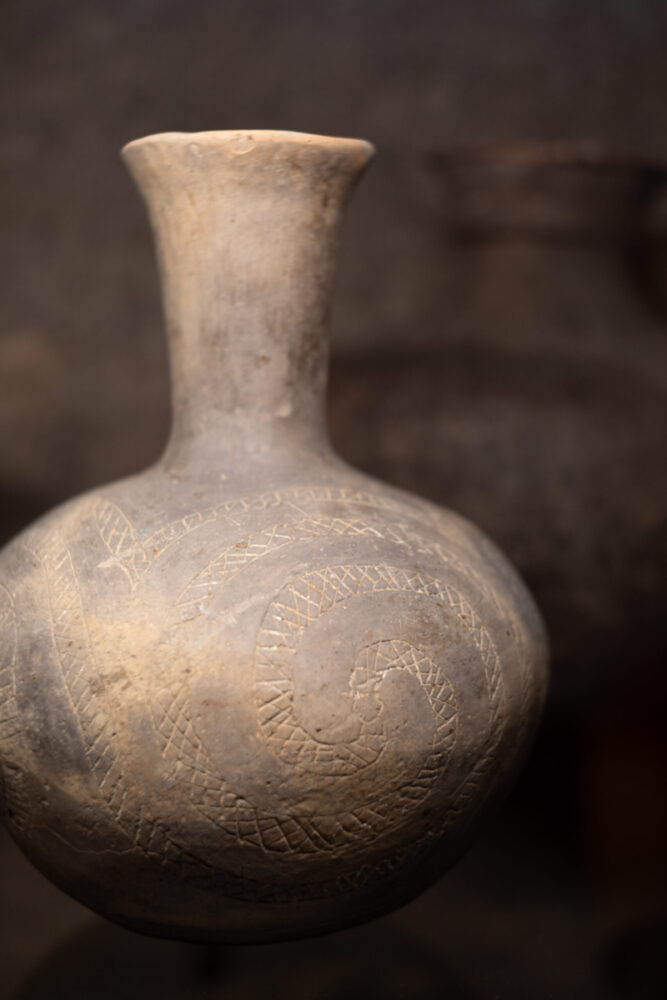Tunica-Biloxi Tribe
The Tunica people, skilled traders and entrepreneurs who engaged with French colonists in the eighteenth century, merged with several other historical Louisiana tribes in the twentieth century.
This entry is 6th Grade level View Full Entry

Brian Pavlich
An incised clay vessel associated with the Tunica Bayou settlement.
What where the effects of the initial contact with Europeans on the Tunica people?
Historians generally agree that a group of Spanish explorers, under the leadership of Hernando de Soto, encountered the ancestors of the Tunicas in 1541. Located in present-day northwestern Mississippi, they built mounds like those commonly found throughout the Mississippi Valley. They also impressed the Spanish with their military and agricultural skills. At that time related tribal groups covered a large region extending along both sides of the Mississippi River in present-day Mississippi and Arkansas.
Diseases transmitted by Spanish explorers dramatically reduced Indigenous populations. For reasons that are not entirely clear—though likely related to their contact with the Spanish expedition—the Tunicas’ ancestors moved south to an area where the Yazoo and Mississippi Rivers meet.
The French first encountered the Tunicas more than a century after the de Soto expedition, near the banks of the Lower Yazoo River. Members of the La Salle expeditions of the 1680s identified the Tunicas as enemies of the Quapaws, who lived near the Arkansas River. The first recorded encounter between the French and Tunicas occurred in 1699, when three missionaries happened upon a group of Tunica villages. The priests described the Tunicas as a peaceful, agricultural people with a complex religious system oriented around a major temple.
How did the Tunica people affect trade and culture?
The Tunicas made a big impact on trade and culture in Arkansas, Louisiana, and Mississippi throughout the eighteenth century. They were skilled traders and entrepreneurs, especially in the manufacture and distribution of salt, a valuable item to both American Indians and Europeans. The French, who so often experienced shortages, relied heavily on the tribe for salt, grain, cattle, and horses. The French also looked to the Tunicas for military support against rival tribes such as the Natchez and the Chickasaws.
Why has the Tunica Tribe migrated multiple times?
Several years after French contact, Tunicas migrated to the area where the Red River and Mississippi River meet. They resettled among the Houmas in an area known as Portage de la Croix (near present-day Angola, Louisiana). In 1706 Tunicas attacked their Houma hosts to develop closer diplomatic and trade relations with the French. In 1731, following the 1729 Natchez Revolt, a group of Natchez refugees attacked the main Tunica village, killing several chiefs and convincing the defeated tribe to migrate once again to an area that is known today as Tunica Bayou.
After the 1763 Treaty of Paris, the tribe left Tunica Bayou after coming in conflict with British forces and allied themselves with the Spanish who had just taken control of New Orleans. In 1764 they settled on the east side of the Mississippi River near Pointe Coupée. Approximately twenty years later the Tunicas moved to the interior of Spanish Louisiana in present-day Avoyelles Parish. Since the 1780s the tribe’s main settlement has remained in Marksville, Louisiana.
Where does the Tunica-Biloxi Tribe live today?
In the early twentieth century, the Tunicas merged with several other historical Louisiana tribes, including the Biloxi, Ofo, and Choctaw Tribes. The combined tribe received federal recognition in 1981, and today the Tunica-Biloxi Tribe is one of four federally recognized Native tribes in Louisiana. As of 2020 there are approximately fifteen hundred enrolled tribal members interspersed throughout Louisiana (40 percent), Texas (32 percent), Illinois (7 percent), and other parts of the United States (21 percent). The Tunica-Biloxi reservation is located just south of Marksville in east-central Louisiana. Tribal lands comprise approximately 1,717 acres of property in Avoyelles and Rapides Parishes.
The resilience of the Tunica-Biloxi to disease, warfare, displacement, and resettlement is a testament to the tribe’s collective ability to adapt to the social, cultural, and economic challenges that came with more than four hundred years of colonial activity. Their legacy as entrepreneurs, diplomats, and good neighbors continues today.
